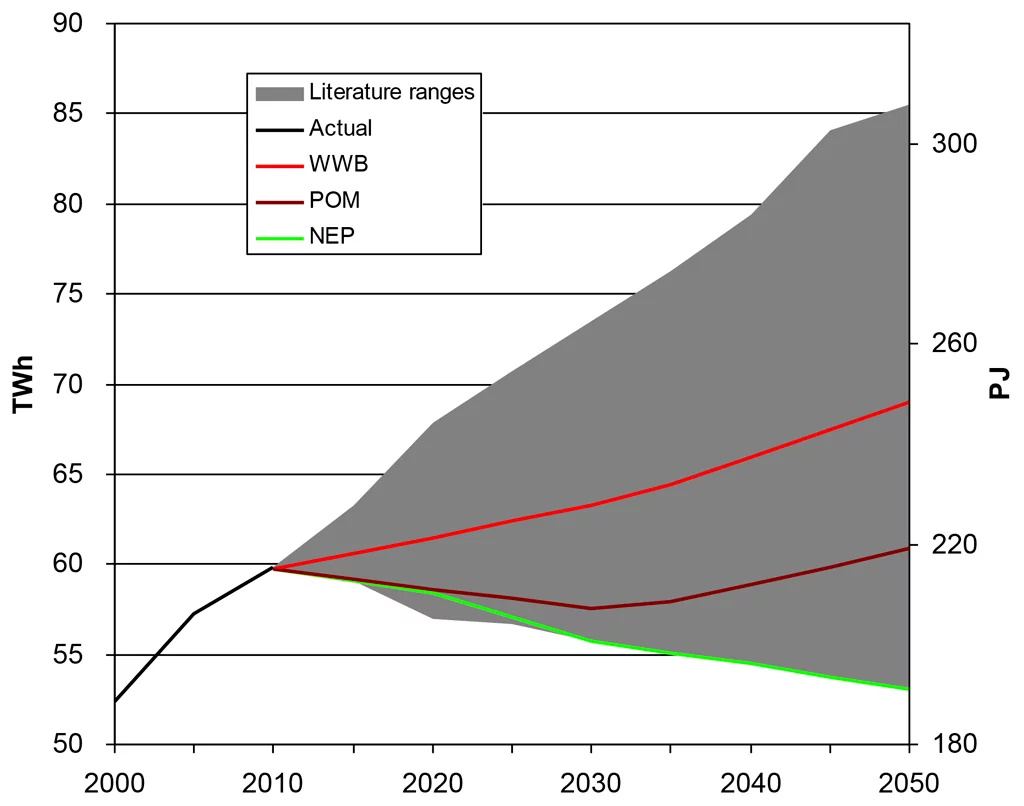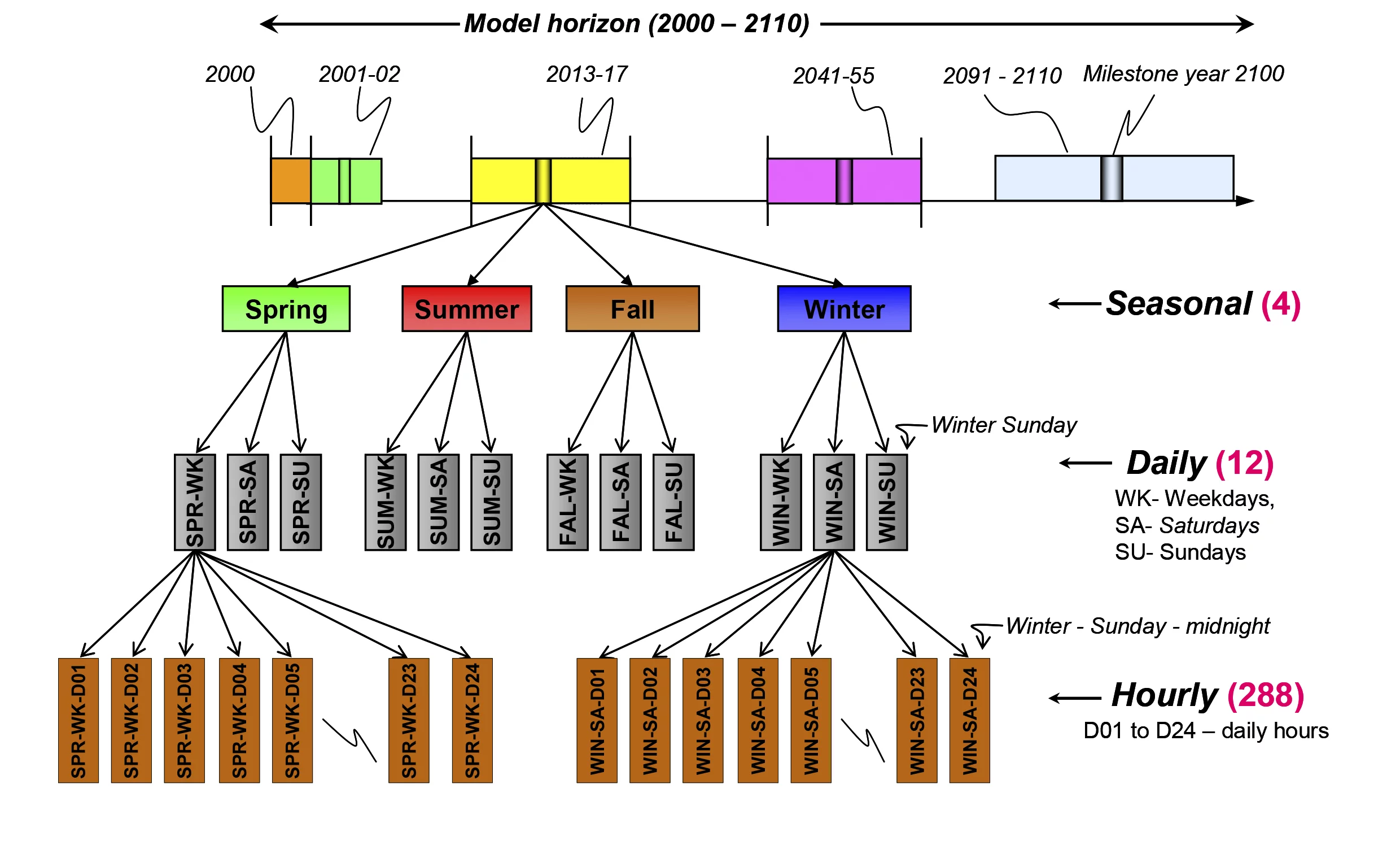Switzerland is facing a potentially radical restructuring of its energy system in the light of the Federal Government's Energy Strategy 2050. One particular challenge associated with achieving the goals of the Strategy is realizing an electricity supply sector that responds to uncertain developments in electricity demand, national climate targets and the decision to phase out nuclear power. In order to investigate options for this transformation of the electricity sector, researchers at the Paul Scherrer Institute (PSI) are developing and analyzing a range of alternative scenarios of the future electricity system in Switzerland. These scenarios are developed, quantified and explored with an analytical tool built at PSI that simultaneously examines long-term developments (to 2050 and beyond) while accounting for seasonal and daytime fluctuations in electricity demand and supply.
The analytical tool – called STEM-E – is designed to take into account the peculiarities of the Swiss energy system. For instance, in Switzerland electricity production and demand vary substantially across the seasons. Electricity demand is high in winter when production from Switzerland's hydroelectric power stations is low; conversely, in summer months demand is lower, while output from hydroelectric power stations is high. Accordingly, imports of electricity are needed in winter and surplus electricity is exported during summer, and thus international electricity trading with the rest of Europe is central to managing the Swiss electricity system. Historically, imports and exports of electricity tend to balance over the year.
Another particular feature of Switzerland is that the country has many good sites for pumped storage hydro power stations, some of which are already developed and in operation. Pumped storage hydro not only plays an important role in electricity trading, but has the potential to contribute to the future integration of the new renewable electricity sources such as solar and wind. This is because solar and wind power can not be switched on and off according to demand for electricity, but instead depend on when the sun is shining and the wind is blowing. When the output from solar and wind exceeds demand, the surplus can be stored in pumped hydro stations (by pumping water from a lower reservoir to a higher reservoir), and released later when needed in order to balance supply and demand on an hourly basis. These features are represented in PSI analytical tool.
Uncertain power demand and supply
The electricity system in Switzerland today already has to cope with a number of uncertainties during the balancing of supply and demand. These include uncertainties on the demand side related to decisions of individual households, businesses and industry. While power demand has increased in Switzerland in the recent past, the typical daily fluctuations in power demand, with peaks and troughs at certain times of the day, has remained relatively unchanged over recent years. However, future developments such as a significant expansion of electric mobility, an increase in demand for air conditioning or a change from fossil fuels for heating to electric heating could lead to significant changes in daily consumption profiles.
There are also uncertainties in the supply of electricity, including climatic variations such as the precipitation volume which affects the amount of electricity generated seasonally by the Swiss hydroelectric power stations. In the future, it is likely that additional uncertainties will emerge in daily and seasonal variations in electricity production if renewable electricity sources such as photovoltaics and wind power are expanded. STEM-E is well-suited to analysing such medium-term and long-term developments, since it uses a mathematical algorithm to optimise the demand and supply from today until the second half of the 21st century, on an hourly basis for each of the four seasons, distinguishing between weekdays, Saturdays and Sundays.
In addition to some of the uncertainties mentioned above, options for Switzerland will also be affected by other important (and uncertain) factors such as global economic growth, the sensitivity of the climate system to changes in the CO2 concentration in the atmosphere, and decisions relating to energy policy in other countries. These can affect, for example, the availability and price of imported electricity, which is critical to the Swiss electricity system today, along with the availability of other imported fuels (such as natural gas) which could be used to produce electricity in the future.
Accordingly, the development of Switzerland’s electricity system, and the realization of the Federal Government's Energy Strategy faces major uncertainties. Neither future electricity demand, technological progress, the effectiveness of efficiency measures, nor future policy decisions can be predicted with accuracy.
Robust against uncertainties
The analytical tool developed by researchers at PSI – STEM-E – is used to generate insights to support strategic decisions in the face of uncertainties such as those described above. Uncertainties are tackled by developing a range of "what-if" scenarios incorporating different assumptions of future uncertainties. This means that the consequences of different technological, political and economic developments are analysed and the effect of uncertainties is quantified, and robust options are identified (e.g., technologies that are attractive across a wide range of uncertainties). Researchers call this a scenario analysis. Such an analysis may focus on, for example, fluctuations in natural gas prices or variations in future cost of technologies.
The PSI scientists have used STEM-E to analyse various scenarios and identify cost-effective strategies for Switzerland to achieve a climate-friendly or import-independent power supply over the 21st century (1,2,3). The model compares the overall costs of competing technologies and identifies the lowest cost mix. The calculation can include all aspects of a technology, from the capital investment for the power plants and other infrastructure, to the procurement costs for fuels, to the decommissioning of the plants and the disposal of waste.
A unique, transparent analysis tool
Models for analyzing future power demand and supply have been around for a long time. For example, the electric utilities use models to estimate the power requirements in their supply area. However, these models tend to focus on the very short term (just a couple of days to 1-2 years), because they are used by the power companies to optimise the daily operation of their power plants rather than for the long-term planning of resources or investments. In the scientific community, on the other hand, models have been developed with a very long time horizon (several decades or an entire century), but with a coarse time resolution that doesn’t account for daily or hourly fluctuations in supply and demand. "No previous analysis tool in the public domain combines the long-term and high time resolution of the STEM-E model," says Stefan Hirschberg, head of the Laboratory for Energy Systems Analysis at PSI. PSI’s model is also built using a well-established, open-source modelling framework developed by the International Energy Agency.
The PSI researchers are already planning to expand their model, in order to investigate the entire energy system rather than just the electricity sector. Such a full energy system model will be able to incorporate directly some of the uncertainties facing the Swiss energy system (such as uncertainties related to a shift to electric vehicles or electric heating systems).
The results of calculations with the STEM-E model regarding the future of the Swiss electricity sector are available in PSI’s latest Energie-Spiegel publication (2), and will be recapitulated in a subsequent paper.
Note: A technical report describing the STEM-E model can be found by clicking on the following link: http://gabe.web.psi.ch/pdfs/ES21_Stem-E_Documentation_Final_R2.pdf
Additional information
- Cost of ad-hoc nuclear policy uncertainties in the evolution of the Swiss electricity system, Kannan Ramachandran and Hal Turton, Energy Policy, Volume 50, November 2012, DOI: 10.1016/j.enpol.2012.07.035
- http://gabe.web.psi.ch/pdfs/Energiespiegel_21_d.pdf
- http://gabe.web.psi.ch/pdfs/ES21_Supplementary%20-%20Energie%20Spiegel%20Nr%2021.pdf



